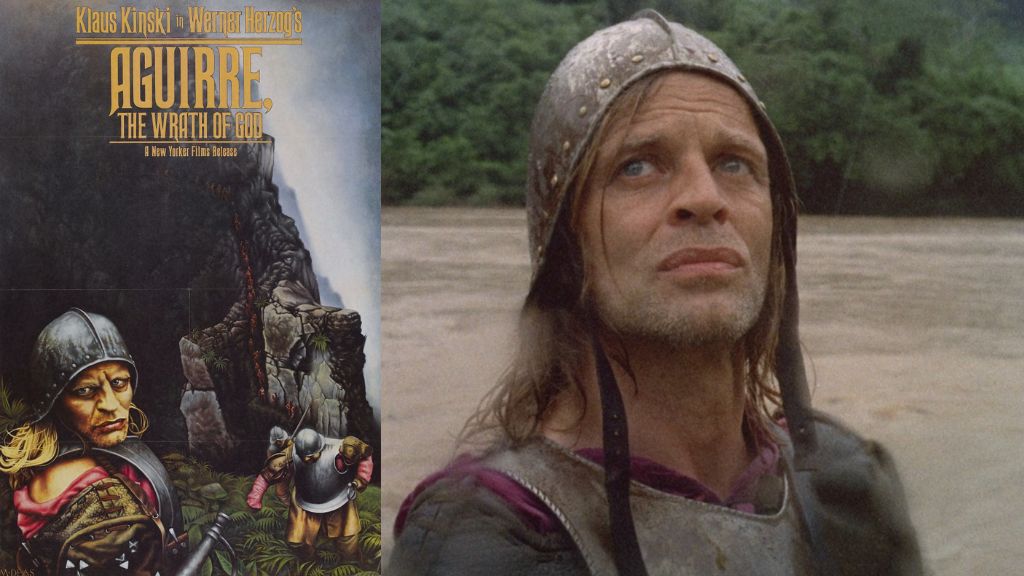The Conquest of Madness: Aguirre and the Perils of Power

Werner Herzog, director of Aguirre, the Wrath of God, sought a location atop a mountain near Machu Picchu in Peru to shoot the opening scenes. He led his cast and crew of 450 people, together with a procession of horses, pigs, and llamas, up the mountainside. His group slogged down an ancient stairway carved into the rocks by the Incans centuries ago, traveling through dense jungle on steep footing made slick by rain. Clouds blanketed the entire mountain, shrouding everything in dense, moist fog, allowing no visibility. Even the local upland tribes got vertigo-stricken at 14,000 feet, but the players withstood the conditions in their heavy costume armor and Spanish conquistador clothing.
The journey appeared impossible. Herzog had to persuade his crew to keep going, to keep ascending higher and higher along a vertical drop of almost 2,000 feet. Herzog was concerned that their efforts had been in vain when they arrived at their destination. The clouds eventually cleared, and daylight broke through. Herzog got his shots, capturing a line of actors, barely specks in the frame, descending down the Incan stairway between a severe mountain slope and a cloud of fog. Herzog believed a miracle had occurred. He reflected on his good fortune, saying, "It was on this day that I definitely came to know my destiny." Ironically, it was that kind of mad determination and assumption of fate that pushed his film's zealous protagonist, Lope de Aguirre.
Before he was recognized for filming documentaries like Grizzly Man (2005) and Encounters at the End of the World (2008) about people consumed by passion in remote, unattainable locales, Herzog made narrative films about the same subject, demonstrating that he shared their obsession. Aguirre, the Wrath of God was Herzog's first such picture, as well as his first international hit outside of his own West Germany. His 1972 film depicts a failed Spanish voyage to find El Dorado, the legendary Incan city of gold.
A fever dream
On the surface, the film looks to be a traditional period adventure about the fight between humans and nature, with Spanish conquistadors venturing into the unknown to collect treasure, only to be defeated by the unconquered forest. However, upon closer observation, the entire picture is set in a fever dream of obsessive urges. After all, what better example of crazy than conquistadors marching off in a specified direction with hundreds of troops and resources in tow, hoping to discover a place whose location is unknown and, ultimately, does not exist? Many of Herzog's greatest films feature rebels against both humanity and nature.
They strive for an unachievable goal, possibly out of pride or vanity, but they are eventually swallowed and regurgitated by Nature. Herzog knew these obsessions better than most; he later experienced them when filming Fitzcarraldo (1982), as well as countless other tales and documentaries, including Aguirre, the Wrath of God. He exhibits his own obsession by directing this ambitious film to follow his subject into the heart of darkness, rather than filming on a studio lot or a safer place.

Detachment from reality
Herzog never meant to make Aguirre, the Wrath of God into a historical account of Lope de Aguirre's life and times. In reality, his initial concept for the picture was inspired by a children's book that included a brief segment on Aguirre. What captivated the director the most was the figure's complete craziness. When Aguirre joined Don Pedro de Ursúa's expedition to find El Dorado, he already had a reputation for being a vicious and ruthless conquistador. On the trip, Aguirre overcame his superiors and took command. In a manic letter discovered during Herzog's research, Aguirre denounces King Felipe II of Spain, declaring him "dethroned and stripped of all rights," and renaming himself "the Wrath of God."

He went on to declare himself "the new Emperor of El Dorado and New Spain" and led his captured expedition into the unknown. Finally, he arrived at the Atlantic, no closer to discovering El Dorado, and all but a few of his followers had died. This daring, this detachment from reality while immersed in nature, drew the director in, and Herzog determined to recreate it in his film. "Aguirre is one of history's great losers," the filmmaker once stated in an interview, and the concept of Aguirre's unusually fixated worldview layered his screenplay more than actual reality. "The entire script is pure invention," Herzog revealed in an interview. What he meant to represent was not facts and dates, but the frame of mind attributed to Aguirre, the type of adventurer who seeks a wealth of riches while also pursuing his own death.
